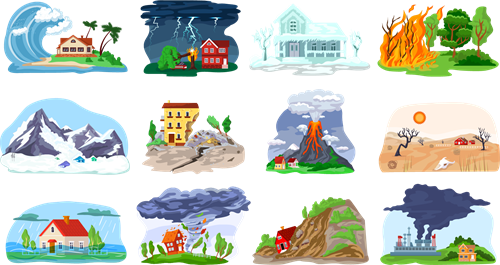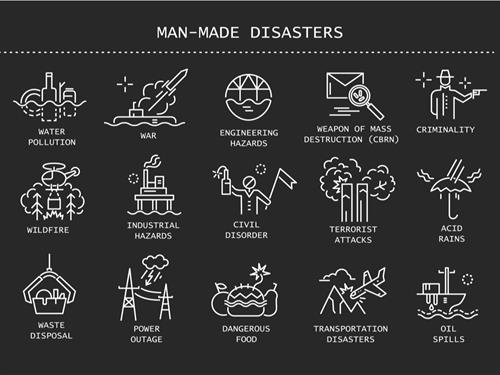PDF chapter test TRY NOW
Introduction:

1. Hazardous materials
2. Power service disruption & blackout
3. Nuclear power plant & nuclear blast
4. Radiological Emergencies
5. Chemical threat and biological weapons
6. Cyber Attacks
7. Explosion
8. Civil unrest. 
Man-Made Disasters
Natural disasters and disasters that have occurred in various parts of the world are reported in practically all newspapers and television news channels on a daily basis.
Although neither all threats nor all disasters can be avoided, the damage can be reduced.
Natural disasters and disasters are widespread throughout the world, not just in India. Disasters can be sudden, like earthquakes, floods, or storms, or slow, like droughts or famines. Geo-climatic factors have made India vulnerable to natural calamities.
Hazard:
The phrase hazard can refer to a variety of things. Frequently, dictionaries do not provide detailed definitions of the term or mix it up with the word "danger". For example, one textbook describes hazard as "a danger or risk", which explains why many people confuse the two words.
Any source of potential injury, harm, or adverse health effects on something or someone is considered a hazard. A hazard is any source of major damage, harm, or health implications on something or someone.
There are many definitions for potential danger, but the most common example when describing a safe and healthy workplace is: A danger is any means of generating damage, endangerment, or health implications on something or someone.
A hazard is described as the ability for harm or a negative outcome.
Example:
To people as health effects, to organizations as property or equipment losses, or to the environment.
Disaster:
Disasters are major disruptions to the functioning of a community beyond the community at large ability to manage using its resources. Natural, man-made, and technical hazards, as well as a number of other factors that impact a community's risk and vulnerability, can all play a significant role in catastrophes.
Types of Disaster:
I) Natural Types of Disasters:
| Agricultural diseases & pests | Damaging Winds |
| Drought and water shortage | Earthquakes |
| Emergency diseases (pandemic influenza) | Extreme heat |
| Floods and flash floods | Hail |
| Hurricanes and tropical storms | Landslides & debris flow |
| Thunderstorms and lighting | Tornadoes |
| Tsunamis | Wildfire |
| Winter and ice storms | Sinkholes |

Natural Disasters
Because of their size and opportunities and threats related, storms and tropical storms are some of the most powerful natural calamities. Tornadoes are rapidly storms that can generate winds of up to \(200\) miles per hour. Tornadoes and landslides both strike without notice.
Flooding has been the most known natural hazard, and it demands understanding of our atmosphere's natural systems, including wetlands and the regularity of flash floods. When there is dryness, fires are more likely to happen.
II) Man-Made and Technological Types of Disasters:
1. Hazardous materials
2. Power service disruption & blackout
3. Nuclear power plant & nuclear blast
4. Radiological Emergencies
5. Chemical threat and biological weapons
6. Cyber Attacks
7. Explosion
8. Civil unrest.

Man-Made Disasters
